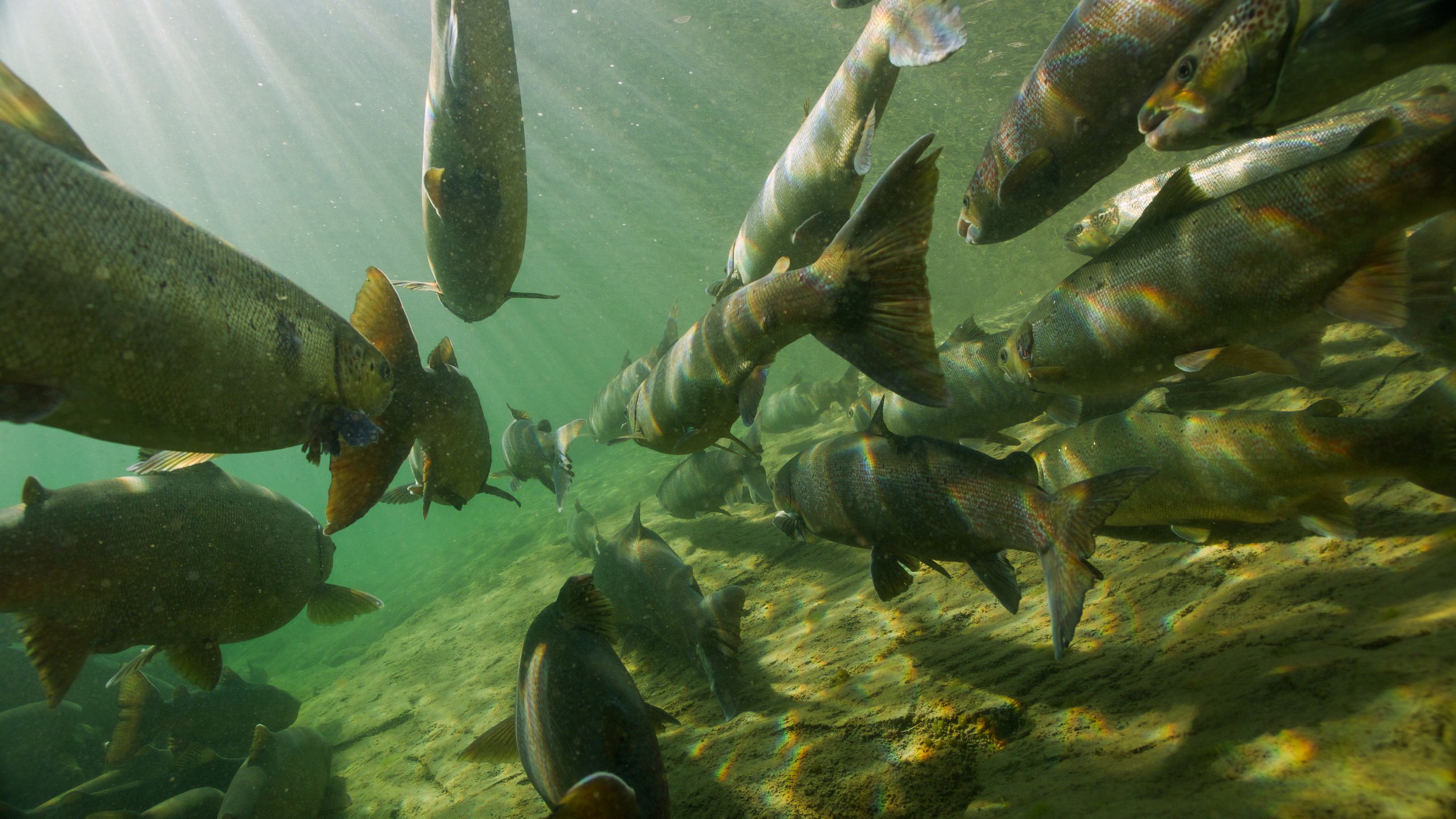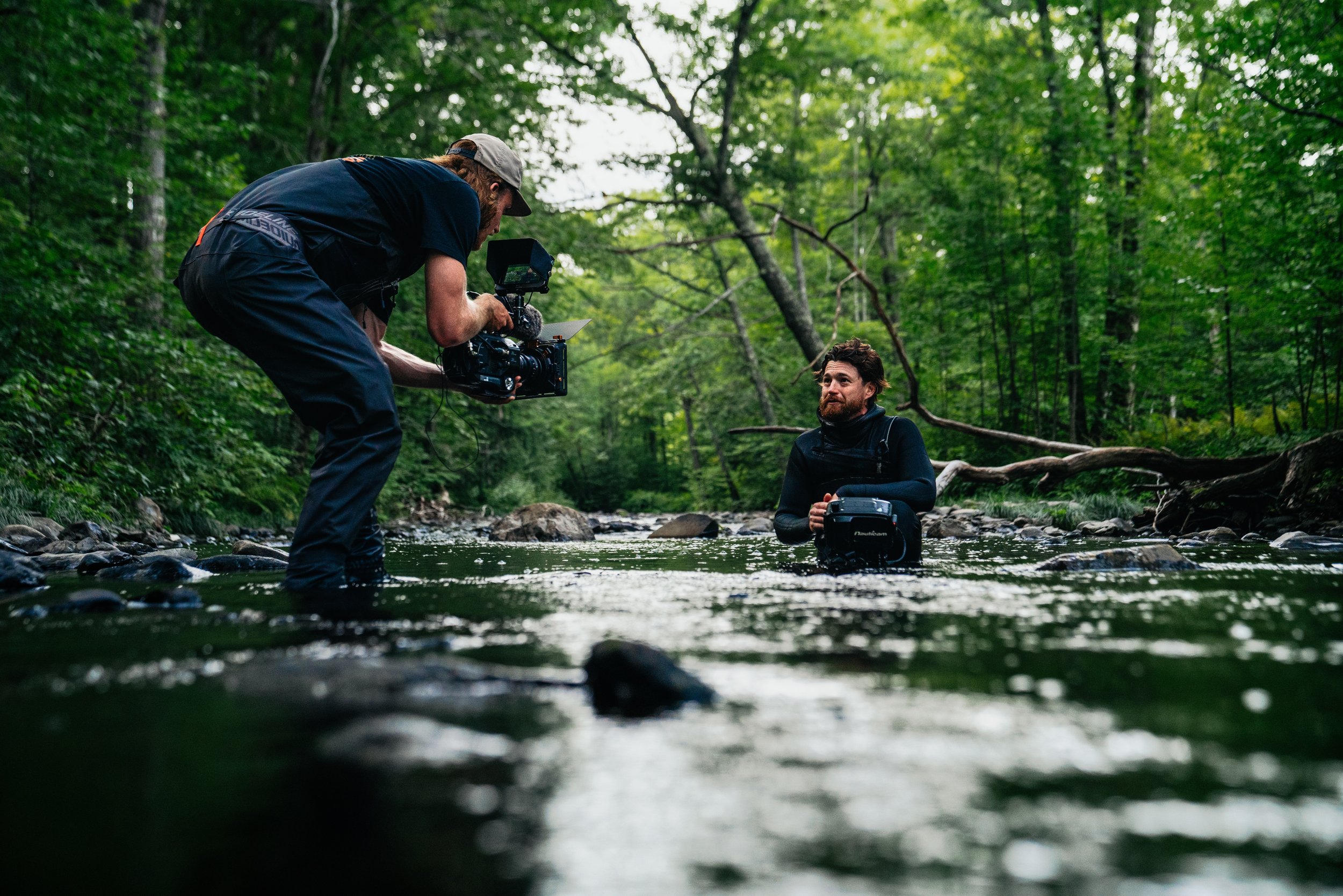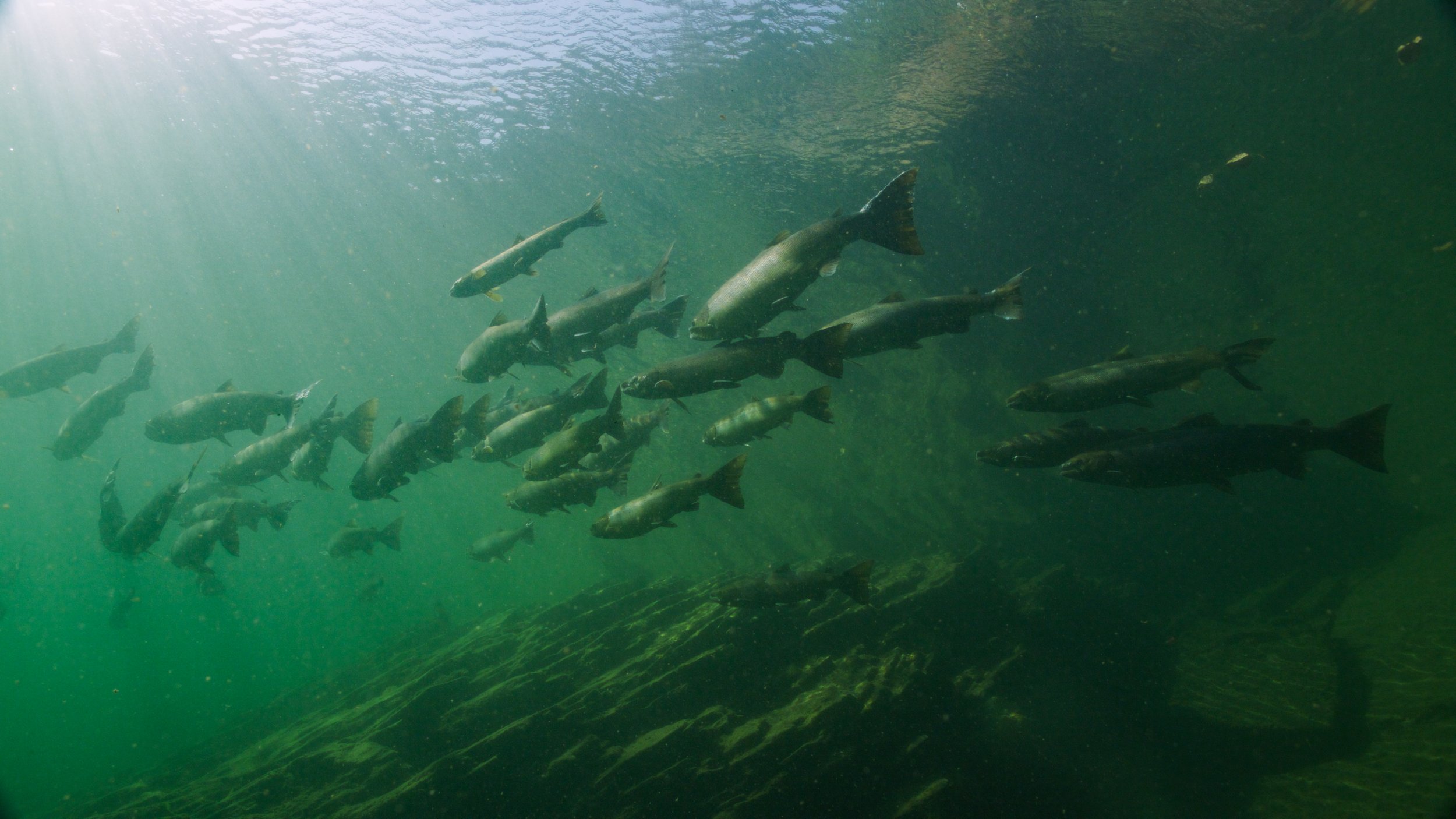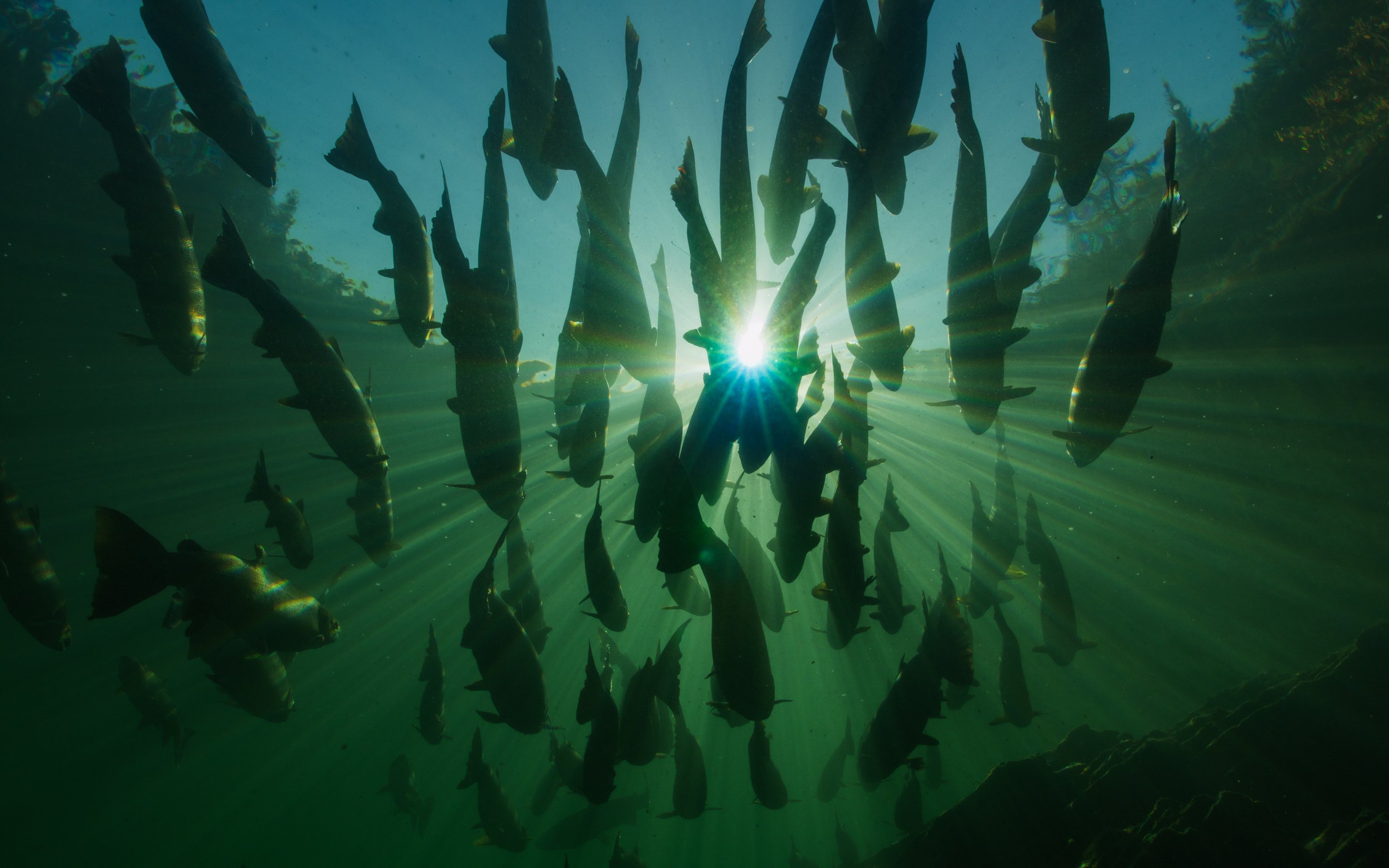
Atlantic Salmon: The Fight to Survive
Revealing the Epic Life Story of the Atlantic Salmon
2024 Trebek Grantee
Nick Hawkins
2024 Trebek Grantee and National Geographic Explorer Nick Hawkins uses cutting-edge underwater cinematography to capture the epic migration of Atlantic salmon, revealing their journey from Canadian rivers to Greenland's icy fjords.
Documenting a Story of Challenge and Resilience
Nick Hawkins, a wildlife filmmaker and National Geographic Explorer, is embarking on an ambitious mission to document the extraordinary life story of the Atlantic salmon.
Atlantic salmon are the lifeblood of ecosystems and communities along their migratory route. However, their numbers have plummeted due to habitat destruction, climate change, and diseases linked to aquaculture practices.
Through dramatic and innovative cinematography, Nick will reveal in never before seen detail the incredible journey of this keystone species along with the passionate efforts of those trying to reverse its precipitous decline.
EXPLORE THIS PROJECT
PHOTOS FROM THE FIELD
Behind the Lens: Capturing Wild Atlantic Salmon
Nick Hawkins joined the Atlantic Salmon Federation and Hooké to document the return of wild Atlantic salmon in Maine’s rivers. Once near collapse from habitat loss, the salmon’s resurgence in waterways like the Sandy River symbolizes hope. Capturing their story required navigating rugged terrain and relying on local expertise, underscoring the dedication needed to bring these images to life.
SCIENCE OF SALMON
Salmon: The Lifeblood of Ecosystems and Communities
Atlantic salmon are more than just fish; they are vital to ecosystems, cultural traditions, and local economies. Nick Hawkins’ work dives into the essential role of salmon, from supporting nutrient cycles to maintaining Indigenous practices and sustaining coastal communities. Healthy salmon create a ripple effect, benefiting nature and people alike.
CONSERVATION
Explore the Barriers to Atlantic Salmon Migration
Atlantic salmon are resilient, yet they confront several barriers threatening their survival. From climate change and habitat loss to open-net pen aquaculture, these challenges impact both their populations and ecosystems. Understanding and addressing these obstacles is key to developing successful conservation strategies. Discover what is being done to help the salmon overcome these barriers.
STORIES OF HOPE
Revival in Action: The Edwards Dam Legacy
The Sandy and Kennebec Rivers reveal a story of renewal. A quarter-century after the Edwards Dam removal, Atlantic salmon are returning to their historic spawning grounds. Witness the impact: revived salmon populations, including crucial sea-winter fish, and healthier river ecosystems. Join Nick Hawkins and the crew as they document this journey of resilience and explore lessons for future salmon recovery.

Healthy Wild Atlantic Salmon
Directly improves the ecosystem + community
Atlantic salmon are keystone species, meaning their health directly impacts entire ecosystems. Their life cycle supports nutrient cycling in both freshwater and marine environments, providing essential nutrients that benefit a wide range of organisms, from insects to large mammals. This nutrient transfer is crucial for maintaining the productivity and biodiversity of these ecosystems.
Ecological Contributions of Atlantic Salmon
Atlantic salmon play a crucial role in maintaining the health of both freshwater and marine ecosystems.
As a keystone species, their life cycle impacts multiple layers of the food web, directly supporting nutrient availability, predator populations, and plant growth.
The presence of salmon creates a ripple effect that sustains biodiversity, helps stabilize ecological balance, and fosters productive environments.
-
Spawning salmon release essential nutrients like nitrogen and phosphorus, which are vital for algae and aquatic plant growth.
This supports the base of the aquatic food web, sustaining microorganisms to large predators and ensuring ecosystem health.
-
Salmon are crucial for predator species like bears and eagles, providing a reliable food source that helps maintain ecological balance.
-
Decomposing salmon boost the growth of aquatic plants, which provide habitat and food for various aquatic organisms - fostering diverse and productive environments.
Deep Cultural Connections
Atlantic salmon hold profound significance for many Indigenous communities, who have relied on these fish for food, social and ceremonial purposes.
Salmon fishing and consumption are intricately woven into their traditions. They are a crucial food source and integral to ceremonial and spiritual life.
-
Indigenous communities perform ceremonies to honor salmon, reflecting deep respect and gratitude.
-
Traditional fishing practices are passed down through generations, maintaining cultural heritage and reinforcing cultural identity.
-
Salmon provide essential nutrients, and traditional preservation methods like smoking and drying ensure food security and cultural continuity.
Vital to the Local Economy
Catch and release recreational salmon fishing has historically been a vital industry for many coastal communities in Atlantic Canada, providing jobs and supporting local economies. Recreational fishing for Atlantic salmon generates significant revenue and employment opportunities.
-
Recreational salmon fishing attracts anglers from around the world, generating substantial income for guides, lodging, and local businesses.
In 2010, wild Atlantic salmon were worth $255 million and supported 3,872 full-time equivalent jobs in eastern Canada.
-
Tourism from recreational fishing stimulates local economies, supporting a wide range of enterprises from hospitality to retail and providing economic stability and growth for coastal communities.

“Atlantic salmon are essential to the health of our rivers and oceans. Their decline signals a greater environmental crisis, one that impacts not just marine life but human life as well”
It is a good thing salmon are resilient
Atlantic salmon face numerous threats that jeopardize their survival and ecosystems. Climate change, habitat degradation, and aquaculture have created barriers affecting their migration, spawning success, and overall survival. Addressing these challenges requires understanding the issues and implementing effective conservation strategies. Below, we explore the major challenges, starting with the impacts of climate change.

ISSUE #1
Climate Change
Climate change poses a major threat to Atlantic salmon populations, affecting their habitats and survival.
Rising temperatures, changing water flow, and ocean conditions are reshaping their environment, making it increasingly difficult for salmon to thrive.
-
Warmer water temperatures reduce dissolved oxygen levels, increasing stress and mortality for salmon.
These changes disrupt migration timing and limit suitable habitats.
Sources: Atlantic Salmon Trust, EPA
-
Shifts in ocean currents and increased acidification affect prey availability and overall ecosystem health - making the marine phase of salmon life even more challenging.
Sources: NOAA, Climate Change and Atlantic Salmon
-
Targeted actions are being taken to protect salmon from the impacts of climate change:
Restoring Habitats for Salmon Resilience: Reforestation, wetland rehabilitation, and barrier removal are crucial for boosting habitat resilience against climate change.
Source: NASCOResearch and Monitoring for Adaptive Strategies: Increased research and monitoring help understand climate impacts and develop adaptive conservation strategies.
Source: NOAA FisheriesCommunity-Led Adaptation Initiatives: Local communities, including Indigenous groups, apply traditional knowledge to develop effective climate adaptation solutions.
Source: Fisheries and Oceans Canada
-
Countries around the world are taking steps to support Atlantic salmon:
Norway: Implementing habitat restoration projects and sustainable aquaculture practices to support wild salmon populations.
Source: Norwegian Directorate of FisheriesCanada: The Wild Salmon Policy and Indigenous-led projects focus on restoring and protecting salmon habitats.
Source: Fisheries and Oceans CanadaScotland: River restoration and climate adaptation initiatives like the River Dee Project are showing positive outcomes for salmon recovery.
Source: Scottish GovernmentUnited States: State-led initiatives in the Pacific Northwest emphasize habitat restoration, dam removal, and climate resilience.
Source: NOAA Fisheries

ISSUE #2
Habitat Degradation
Habitat degradation has been a major factor in the decline of Atlantic salmon.
Urbanization, deforestation, agriculture, and infrastructure development have destroyed or altered crucial spawning and rearing habitats, severely impacting salmon's ability to reproduce and thrive.
The ongoing loss of suitable habitats continues to pose a significant threat to salmon populations.
-
Historical Impact: Dam construction, deforestation, and agricultural expansion have led to habitat loss and fragmentation, significantly reducing salmon populations.
Source: Atlantic Salmon FederationCurrent Trends: Habitat degradation accounts for an estimated 30% of the decline in Atlantic salmon populations. Despite restoration efforts, urbanization and industrial activities continue to degrade important habitats.
Source: NOAA FisheriesUrbanization and Infrastructure: Development projects, such as dam construction and road building, have disrupted migration routes and reduced habitat availability, increasing salmon mortality rates.
Source: EPAAgriculture and Logging: Agricultural and forestry practices increase sedimentation and pollution in rivers, degrading water quality and reducing habitat suitability for salmon.
Source: Fisheries and Oceans Canada
-
Recent Trends: Mixed trends indicate some regions have improved due to restoration efforts, while others continue to face severe degradation from ongoing development.
Source: WWFImpact of Climate Change: Climate change worsens habitat degradation by altering river flow, increasing water temperatures, and reducing the availability of suitable habitats.
Source: Climate Change and Atlantic SalmonConservation Efforts: Riparian restoration, dam removal, and improved land-use practices have shown positive effects in mitigating habitat degradation, leading to slight recoveries in some areas.
Source: Atlantic Salmon TrustOngoing Challenges: Despite progress, habitat degradation remains a significant challenge due to urbanization, industrial activities, and insufficient enforcement of environmental regulations.
Source: GEF
-
Regulations and Policies: The Fisheries Act and salmon-specific guidelines enforce regulations to protect and restore critical habitats, ensuring water quality and ecosystem health.
Source: Fisheries and Oceans CanadaHabitat Restoration Projects: Projects like those led by the Atlantic Salmon Federation focus on removing migration barriers, restoring spawning grounds, and reforesting riparian areas to support salmon recovery.
Source: Atlantic Salmon FederationCommunity Involvement: Local communities, Indigenous groups, and conservation organizations collaborate on projects like the Salmonid Habitat Enhancement Program, integrating traditional knowledge with modern techniques to restore vital river ecosystems.
Source: Fisheries and Oceans Canada
-
Canada: Measures like the Wild Salmon Policy and Indigenous-led projects focus on restoring degraded habitats and supporting salmon recovery.
Source: Fisheries and Oceans CanadaScotland: River restoration and monitoring programs, such as the River Dee Project, have shown improvements in salmon returns.
Source: Scottish GovernmentUnited States: State-led initiatives, such as dam removal and riparian restoration, have shown positive results in salmon population recovery in the Pacific Northwest.
Source: NOAA Fisheries

ISSUE #3
Open-Net Pen Aquaculture
Open-net pen aquaculture is a major threat to Atlantic salmon.
Raising salmon in large net pens in coastal waters has led to significant ecological issues, including the spreading of diseases and parasites, pollution, and genetic dilution of wild salmon populations due to escapes.
-
Emergence of the Threat: Open-net pen aquaculture became popular in the 1980s and 1990s due to its cost-effectiveness. However, the ecological consequences, such as disease transmission, pollution, and genetic impacts, soon became apparent.
Historical Impact: The rapid expansion of open-net pen aquaculture introduced significant environmental challenges, including sea lice, pollution from waste, and the escape of farmed salmon, which can interbreed with wild populations and reduce genetic fitness.
Source: WWFDisease and Parasite Transmission: The spread of diseases and parasites like sea lice is a major concern, significantly reducing the survival rates of wild salmon.
Source: EPAPollution: Open-net pens produce waste, including uneaten feed, feces, and chemicals, which degrades water quality and harms marine ecosystems.
Source: Fisheries and Oceans CanadaGenetic Dilution: Escaped farmed salmon can interbreed with wild populations, leading to genetic dilution. Traits bred for captivity, such as reduced fear of predators, can be detrimental in the wild.
Source: NASCO
-
Recent Trends: Despite some improvements, challenges like disease outbreaks and escapes persist, undermining conservation efforts for wild salmon.
Source: WWFImpact on Habitat Restoration: Open-net pens complicate habitat restoration by introducing pollutants and diseases, which can undermine restoration successes.
Source: Fisheries and Oceans CanadaConservation Efforts: Efforts to mitigate the impacts of aquaculture include better farm management, disease-resistant strains, and stricter regulations.
Source: Atlantic Salmon FederationOngoing Challenges: Issues like disease outbreaks, escapes, and pollution continue to pose challenges. Innovative solutions and stricter regulations are needed to reduce the environmental footprint.
Source: EPA
-
Regulations and Policies: Stricter regulations to manage environmental impacts, most importantly; a transition to land-based closed containment systems to better manage waste, spread of disease and escapees.
Innovative Farming Practices: Developing land-based closed containment systems can help reduce many environmental impacts of open-net pen aquaculture.
Source: MSCResearch and Monitoring: Increased research and monitoring help understand the impacts and develop mitigation strategies.
Source: NOAA FisheriesCommunity Involvement: Engaging local communities and stakeholders ensures sustainable and environmentally responsible aquaculture practices.
Source: Fisheries and Oceans Canad
-
Canada: Canada has announced an end to open net-pen aquaculture on the Pacific Coast by 2029.
Source: Fisheries and Oceans CanadaUnited States: Alaska, Oregon, California and Washington have banned open-net pen aquaculture.
Source: NOAA Fisheries
PROJECT UPDATES
Explore Nick’s Stunning Project Images - Capturing Stages of the Atlantic Salmon Migration
Expedition to Sandy River, Maine
Atlantic Salmon Federation staff from the U.S. and Canada welcomed wildlife cinematographer Nick Hawkins, Juliette Larocque, and Nathan Plamondon from Hooké to explore Maine’s wild Atlantic salmon rivers. Their mission: to capture the remarkable return of a species once pushed to the brink by decades of damming and habitat destruction. With the help of their expert guides, Nick and his crew documented the stunning resilience of the salmon—capturing imagery that tells a powerful story of recovery.
The Sandy River is a beacon of hope; one of Maine's best remaining habitats for wild Atlantic salmon. But there is still work to be done, if more dams are removed the future for these iconic fish will look even brighter.
Behind the Scenes: Sandy River, Maine
PROJECT BACKGROUND



Explore Further
Stories from the Trebek Initiative’s Media Partners
Atlantic salmon are vital to ecosystems and communities but face numerous challenges. Nick Hawkins’s work captures the resilience of these iconic fish and the collaborative efforts needed to restore their populations.
Explore these related stories from National Geographic and Canadian Geographic to understand more about conservation, ecosystem balance, and the role of traditional and scientific stewardship.
STORIES
The Salmon's Life Mission | Destination WILD
A large group of Atlantic Salmon prepare to battle the deluge of rain and increased water levels to get to the shallow waters upstream and give life to their offspring.
Canada's Salmon Are at Risk—How Tourists Can Help
Atlantic salmon populations in Canada are seriously declining due to habitat loss, climate change, and overfishing.
This National Geographic article explores how tourists can play a role in conservation—by choosing sustainable travel practices, supporting eco-friendly tourism operators, and engaging with local conservation initiatives. Visitors can help protect these iconic species while also gaining a deeper understanding of salmon's cultural and ecological importance.
Millions of Salmon Return Home | National Geographic
Every four years, millions of sockeye salmon journey thousands of miles from the ocean back to their native spawning grounds in Canada's Fraser River. There, after eggs are laid, the parents die. Then, the cycle begins anew as the next generation of salmon makes its way down the river and into the ocean.
STORIES
Mapping the Threat Status of Wild Atlantic Salmon
The Atlantic Salmon Federation has developed a mapping tool to assess the health of wild Atlantic salmon across northeastern North America.
This tool visualizes the threat status in over 1,100 rivers, highlighting areas where populations are at risk or have disappeared.
The initiative aims to guide conservationists in addressing data gaps and targeting restoration efforts to protect this iconic species.
Follow Trebek on Instagram
For more inspiring stories and discoveries from the Trebek Initiative.
Stay informed about groundbreaking projects like Kirsten's and witness the journey of exploration, innovation, and hope that illuminates and inspires appreciation for Canada's rich natural and cultural heritage.











































